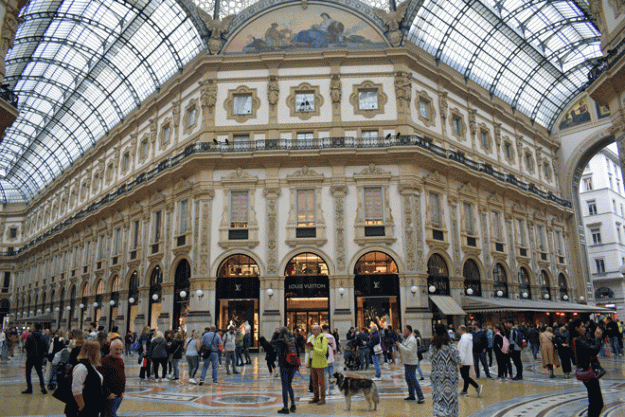
The magnificently named Galleria Vittorio Emanuele II (in blunt English, King Victor Emmanuel II’s Shopping Centre) is an architectural jewel.
Stretching from the square, Piazza del Duomo, in front of Milan’s magnificent cathedral to the home of the legendary La Scala theatre, Piazza della Scala, the Galleria is colloquially known as “Milan’s drawing room” (il Salotto di Milano), one of the great formal spaces which distinguish the city.
Its architect, Giuseppe Mengoni (1829-1877), after twelve years’ work on the gallery’s construction, fell to his death during a final inspection two days before the royal opening by the king whose name it bears.
Mengoni combined splendid décor with engineering virtuosity to provide two barrel-vaulted, top-lit, galleried passages intersecting at an octagon surmounted by an iron-and-glass dome 123 feet in diameter and 56 feet high.
It was by no means the first such covered shopping arcade in a major city. The genre dates back to the Parisian Passage des Panoramas (1800), London’s Burlington Arcade (1818) and the Royal Saint-Hubert Galleries in Brussels (1847), but the Milan Galleria – larger than any of its predecessors – presented an unprecedented spectacle for shoppers.
It inspired a succession of splendid malls such as the Galleria Umberto I in Naples (Emanuele Rocco, 1890) and two of Britain’s finest arcades, the Leadenhall Arcade (Sir Horace Jones, 1881) in the City of London and County Arcade, Leeds (Frank Matcham, 1898-1904).
The Galleria Vittorio Emanuele II is, inevitably, the sort of shopping opportunity where if you need to ask the price you can’t afford the goods.
It’s the prime Milanese location for Giorgio Armani, Gucci, Prada, Swarovski and Louis Vuitton – brands that can position two pairs of shoes in a sumptuously decorated window and wait for the customers to stroll in. Most visitors, of course, look at the windows and stroll on.
McDonalds maintained a discreet presence here for twenty years, but were let go when the lease came up for renewal. They were compensated by premises nearby.
The mosaic floor under the octagon is embellished with the arms of Milan and the three major cities of the Kingdom of Italy – Rome, Florence and Turin – which was united in 1861, the year Mengoni produced the Galleria’s original design.
The arms of the city of Turin illustrate an unmistakably masculine bull, and the Milanese custom is to place your heel on the testicles of the animal and spin 360° for luck. Indeed, if you do this on the stroke of midnight on December 31st you can expect good fortune for the whole year.
The result is that the poor bull’s genitals became entirely obliterated.
I didn’t see this performance when I visited, though I did see an extremely large gentleman sitting, like Buddha, in the middle of one of the coats of arms, while his loved ones took his photo on their phones.
He didn’t spin on his axis.

Pingback: Leadenhall Market | Mike Higginbottom Interesting Times
Pingback: Knightsbridge of the North | Mike Higginbottom Interesting Times